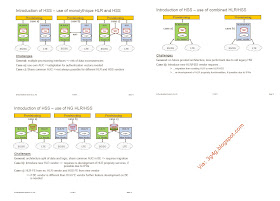Latest News and Information on 4G, 5G, 6G, and other Wired & Wireless Technologies in General.
Pages
▼
Monday, 30 January 2012
Sunday, 29 January 2012
Standardisation on M2M at ETSI M2M platform
Presented by Marylin Arndt, ETSI TC M2M Vice-Chairman in the 2nd FOKUS FUSECO Forum 2011, Berlin 17-18 Nov. 2011
Saturday, 28 January 2012
Webinar: Bridging the gap between LTE and 1xEV-DO
Interesting webinar from Rohde & Schwarz
There are another couple of interesting Video from R&S from the LTE North America 2011
VoLTE and Audio Quality Test
SMS over IMS Verification
There are another couple of interesting Video from R&S from the LTE North America 2011
VoLTE and Audio Quality Test
SMS over IMS Verification
Thursday, 26 January 2012
Diameter Infrastructure Required for LTE (Data) Roaming
Diameter protocol seems interesting especially since we are moving to All IP Networks. This old post gives a comparison of SS7 and Diamater protocol.
You can learn more about Diameter at the Diameter Learning Center.
Wednesday, 25 January 2012
Tuesday, 24 January 2012
Monday, 23 January 2012
Sunday, 22 January 2012
What is coming next after LTE and IMT-Advanced
Interesting presentation from NSN
Other related posts:Saturday, 21 January 2012
Monday, 16 January 2012
Saturday, 14 January 2012
Tuesday, 10 January 2012
Monday, 9 January 2012
Overview of LTE Handovers
From the NTT Docomo Technical journal:
The LTE handover is broadly divided into a backward handover (PS handover) and forward handover. In the former, the network performs cell switching and notifies the mobile terminal of the destination cell, and in the latter, the mobile terminal performs autonomous switching to pick up the destination cell.
To control packet loss due to a momentary cutoff at the time of radio switching, PS handover supports a data forwarding process that transfers undelivered data from the switching-source eNodeB to the switching-destination eNodeB and a reordering process that corrects sequencing mistakes between forwarded data and new data.
The forward handover can be classified into Release with Redirection triggered by a cutoff signal from the network and Non Access Stratum (NAS) Recovery in which the mobile terminal autonomously performs a NAS recovery, either of which is accompanied by data loss due to a momentary cutoff. From a different perspective, handover can be classified in the following two ways according to whether it is accompanied by Radio Access Technology (RAT) or frequency switching or by eNodeB or EPC switching (Figure 7).
1) Intra-RAT handover: This is a handover that occurs within the LTE system in which node transition occurs between sectors within an eNodeB, between eNodeBs within an EPC switch, or between EPC switches.
A handover between eNodeBs within an EPC switch may be an X2 or S1 handover. In an X2 handover, signal processing is performed by the X2 logical interface between eNodeBs, while in an S1 handover, signal processing is performed by the S1 logical interface between an eNodeB and the EPC switch. There is a tradeoff between the cost of maintaining an X2 link and the cost incurred by an S1 handover, and operations are configured accordingly.
Handover can also be classified by whether the center frequency is the same before and after handover, that is, whether the handover occurs within the same frequency or between frequencies.
2) Inter-RAT handover: This is a handover that occurs between RATs either as a transition from LTE to 3G or from 3G to LTE.
A detailed post on LTE to 3G Inter-RAT handover is available here.










